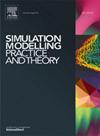A Stochastic Energy-Efficient Robust Simulation-Based Truck Dispatching Optimization for Simultaneous GHG Mitigation and Operational Excellence in Open-Pit Mines
IF 3.5
2区 计算机科学
Q2 COMPUTER SCIENCE, INTERDISCIPLINARY APPLICATIONS
引用次数: 0
Abstract
Almost all currently active large open-pit mines across the globe heavily rely on fleet of shovels and haul trucks for material handling. This material handling system has a significant contribution not only to the production cost of the mine (+50%), but also to its energy consumption (+41%) and greenhouse gas (GHG) emissions (+37%). However, traditionally, operation management in general and truck dispatching, in particular, focused primarily on production targets and operational efficiency, neglecting environmental considerations in open-pit mines. Nowadays, growing awareness of climate change and responsible resource extraction has shifted, however, the focus towards sustainable practices throughout the mining industry, open-pit mining not excluded. The significant contribution of this study lies in the development of an integrated simulation and optimization framework that simultaneously accounts for anthropogenic GHG emissions resulting from energy (fuel) consumption and enhances the operational efficiency of the material handling system, thus yielding direct economic and environmental benefits. The paper fulfills its goals with the aim of simultaneous achievement of four interdependent objectives: minimizing the deviations from target production rates set by strategic plans, minimizing the shovel idle time, minimizing the truck wait time, and minimizing the truck fuel consumption. The performance and the robustness of the proposed framework has been evaluated in a case study at Gol-E-Gohar mine in Iran, demonstrating a successful achievement of up to 6% reduction in fuel consumption per tonne of production leading to a significant overall decrease of up to 20,000 liters in fuel consumption, equivalent to 61,000 carbon dioxide (CO2) emissions, in a 10-day operation with 12 hours of operation per day.
基于随机节能鲁棒仿真的露天矿山温室气体减排与运营优化卡车调度优化
目前全球几乎所有活跃的大型露天矿都严重依赖铁铲和运输卡车车队进行物料搬运。该物料搬运系统不仅对矿山的生产成本(+50%),而且对其能源消耗(+41%)和温室气体(GHG)排放(+37%)做出了重大贡献。然而,传统上露天矿山的作业管理,特别是卡车调度,主要关注生产目标和作业效率,而忽略了对环境的考虑。如今,人们对气候变化和负责任的资源开采的意识日益增强,然而,整个采矿业的重点都转向了可持续实践,露天矿也不例外。本研究的重要贡献在于开发了一个综合模拟和优化框架,该框架同时考虑了能源(燃料)消耗导致的人为温室气体排放,并提高了物料处理系统的运行效率,从而产生了直接的经济和环境效益。本文的目标是同时实现四个相互依存的目标:最小化与战略计划设定的目标生产率的偏差,最小化铲车空闲时间,最小化卡车等待时间,最小化卡车油耗。在伊朗的gole - gohar矿的一个案例研究中,对所提出的框架的性能和稳稳性进行了评估,结果表明,在每天12小时的10天作业中,每吨产品的燃料消耗减少了6%,从而显著减少了高达20,000升的燃料消耗,相当于61,000二氧化碳(CO2)的排放。
本文章由计算机程序翻译,如有差异,请以英文原文为准。
求助全文
约1分钟内获得全文
求助全文
来源期刊

Simulation Modelling Practice and Theory
工程技术-计算机:跨学科应用
CiteScore
9.80
自引率
4.80%
发文量
142
审稿时长
21 days
期刊介绍:
The journal Simulation Modelling Practice and Theory provides a forum for original, high-quality papers dealing with any aspect of systems simulation and modelling.
The journal aims at being a reference and a powerful tool to all those professionally active and/or interested in the methods and applications of simulation. Submitted papers will be peer reviewed and must significantly contribute to modelling and simulation in general or use modelling and simulation in application areas.
Paper submission is solicited on:
• theoretical aspects of modelling and simulation including formal modelling, model-checking, random number generators, sensitivity analysis, variance reduction techniques, experimental design, meta-modelling, methods and algorithms for validation and verification, selection and comparison procedures etc.;
• methodology and application of modelling and simulation in any area, including computer systems, networks, real-time and embedded systems, mobile and intelligent agents, manufacturing and transportation systems, management, engineering, biomedical engineering, economics, ecology and environment, education, transaction handling, etc.;
• simulation languages and environments including those, specific to distributed computing, grid computing, high performance computers or computer networks, etc.;
• distributed and real-time simulation, simulation interoperability;
• tools for high performance computing simulation, including dedicated architectures and parallel computing.
 求助内容:
求助内容: 应助结果提醒方式:
应助结果提醒方式:


